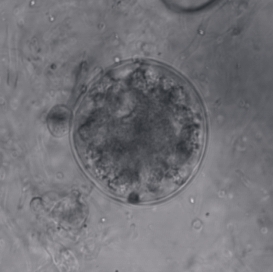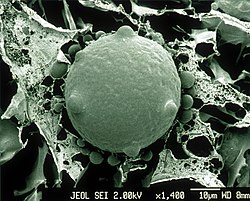Chytridiomycota
Chytridiomycota is a phylum of the Fungi kingdom. The name comes from chytridium (from the Greek chytridion, meaning "little pot"): the structure containing unreleased spores.
| Chytridiomycota | |
|---|---|

| |
| Scientific classification | |
| Kingdom: | |
| Phylum: | Chytridiomycota M.J. Powell 2007[1]
|
| Type species | |
| Chytridium spp. A. Braun, 1851
| |
| Classes | |
The chytrids are the most primitive of the fungi. Many chytrids are found in fresh water. There are approximately 1,000 chytrid species, in 127 genera, distributed among 5 orders.
Chytrids get their energy mostly from non-living organic matter.[2]
Both zoospores and gametes of the chytrids are mobile by their flagella, one whiplash per individual.
Some chytrid species are known to kill amphibians in large numbers. The actual process, however, is unknown.
Chytridiomycota Media
Pennate diatom from an Arctic meltpond, infected with two chytrid-like [zoo-]sporangium fungal pathogens (in false-colour red).
Life cycle of Batrachochytrium dendrobatidis
Life cycle of Synchytrium endobioticum in potato
Synchytrium endobioticum on potatoes.
Sporangium and zoospores of the chytrid fungus B. dendrobatidis, under a scanning electron microscope
Chytrid sporangium and zoospores under the microscope
References
Other websites
- Chytrid Fungi Online Archived 2006-06-27 at the Wayback Machine: by the University of Alabama
- Impact of chytrid fungus on frogs (Foundation for National Parks & Wildlife) Archived 2007-01-10 at the Wayback Machine
- 'Amphibian Ark' aims to save frogs from fungus. Archived 2008-05-10 at the Wayback Machine. Unresponsive 2022.
- The Aquarium Wiki on Chytrid Fungus Archived 2007-09-12 at the Wayback Machine and how it impacts amphibians kept as domestic pets.






